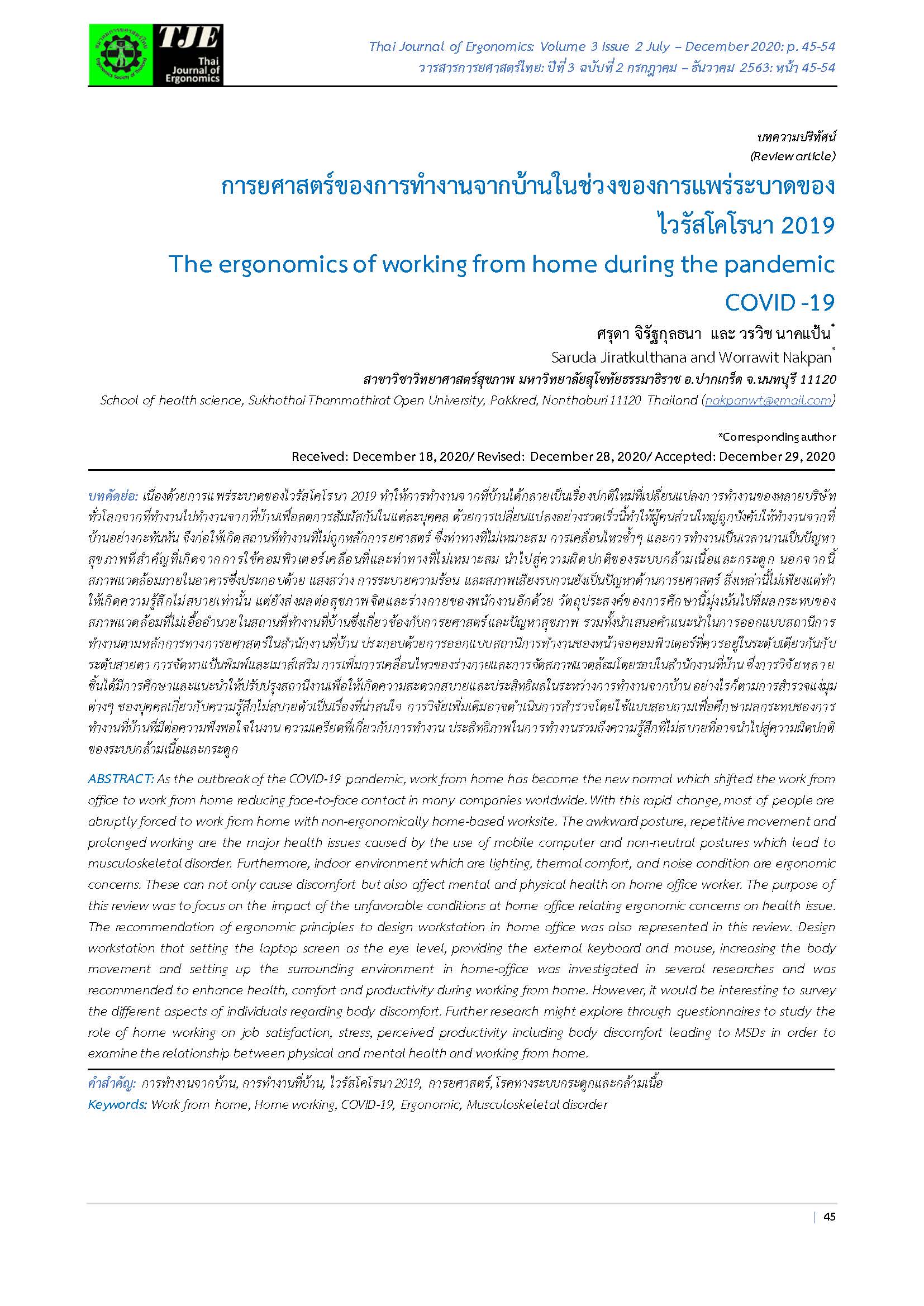The ergonomics of working from home during the pandemic COVID -19
Main Article Content
Abstract
As the outbreak of the COVID-19 pandemic, work from home has become the new normal which shifted the work from office to work from home reducing face-to-face contact in many companies worldwide. With this rapid change, most of people are abruptly forced to work from home with non-ergonomically home-based worksite. The awkward posture, repetitive movement and prolonged working are the major health issues caused by the use of mobile computer and non-neutral postures which lead to musculoskeletal disorder. Furthermore, indoor environment which are lighting, thermal comfort, and noise condition are ergonomic
concerns. These can not only cause discomfort but also affect mental and physical health on home office worker. The purpose of this review was to focus on the impact of the unfavorable conditions at home office relating ergonomic concerns on health issue. The recommendation of ergonomic principles to design workstation in home office was also represented in this review. Design
workstation that setting the laptop screen as the eye level, providing the external keyboard and mouse, increasing the body movement and setting up the surrounding environment in home-office was investigated in several researches and was recommended to enhance health, comfort and productivity during working from home. However, it would be interesting to survey the different aspects of individuals regarding body discomfort. Further research might explore through questionnaires to study the role of home working on job satisfaction, stress, perceived productivity including body discomfort leading to MSDs in order to examine the relationship between physical and mental health and working from home.
Article Details

This work is licensed under a Creative Commons Attribution-NonCommercial-NoDerivatives 4.0 International License.
References
Montreuil S, Lippel K. Telework and occupational health: a Quebec empirical study and
regulatory implications. Safety Science. 2003;41(4):339-58.
Werth AJ, Babski-Reeves K, editors. Assessing posture while typing on portable computing devices in traditional work environments and at home. Proceedings of the Human Factors and Ergonomics Society Annual Meeting; 2012: SAGE Publications Sage CA: Los Angeles, CA.
de Macedo TAM, Cabral E, Silva Castro WR, de Souza Junior CC, da Costa Junior JF, Pedrosa
FM, et al. Ergonomics and telework: A systematic review. Work. 2020;66(4):777-88.
Harrington SS, Walker BL. The effects of ergonomics training on the knowledge, attitudes, and practices of teleworkers. Journal of Safety Research. 2004;35(1):13-22.
Grozdanovic M, Pavlovic-Veselinovic S, editors. Framework for teleworking. 5th International Conference on Telecommunications in Modern Satellite, Cable and Broadcasting Service TELSIKS 2001 Proceedings of Papers (Cat No 01EX517); 2001: IEEE.
Heidari H, Arsang S, Mahmoodi M, Ramezani F. Ergonomic Analysis of the Neck Posture in
Computer Users and Identifying the Related Risk Factors. Archives of Occupational Health.
;3(4):430-7.
Asundi K, Odell D, Luce A, Dennerlein JT. Notebook computer use on a desk, lap and lap
support: effects on posture, performance and comfort. Ergonomics. 2010;53(1):74-82.
Ellison JK. Ergonomics for telecommuters and other remote workers. Professional Safety.
;57(6):86-90.
Seghers J, Jochem A, Spaepen A. Posture, muscle activity and muscle fatigue in prolonged
VDT work at different screen height settings. Ergonomics. 2003;46(7):714-30.
Wahlström J. Ergonomics, musculoskeletal disorders and computer work. Occupational
Medicine. 2005;55(3):168-76.
Fahrbach PA, Chapman LJ. VDT work duration and musculoskeletal discomfort. AAOHN
Journal. 1990;38(1):32-6.
Gerr F, Marcus M, Monteilh C. Epidemiology of musculoskeletal disorders among computer users: lesson learned from the role of posture and keyboard use. Journal of
Electromyography and Kinesiology. 2004;14(1):25-31.
Marcus M, Gerr F, Monteilh C, Ortiz DJ, Gentry E, Cohen S, et al. A prospective study of
computer users: II. Postural risk factors for musculoskeletal symptoms and disorders.
American journal of industrial medicine. 2002;41(4):236-49.
Lundberg U, Lindfors P. Psychophysiological reactions to telework in female and male whitecollar workers. Journal of Occupational Health Psychology. 2002;7(4):354.
Hill EJ, Hawkins AJ, Miller BC. Work and family in the virtual office: Perceived influences of mobile telework. Family relations. 1996:293-301.
Evans O, Patterson K. Predictors of neck and shoulder pain in non-secretarial computer users. International Journal of Industrial Ergonomics. 2000;26(3):357-65.
Sauter SL, Gottlieb MS, Jones KC, Dodson VN, Rohrer KM. Job and health implications of VDT use: initial results of the Wisconsin-NIOSH study. Communications of the ACM. 1983;26(4):284-94.
Bergqvist U, Wolgast E, Nilsson B, Voss M. Musculoskeletal disorders among visual display terminal workers: individual, ergonomic, and work organizational factors. Ergonomics. 1995;38(4):763-76.
Blangsted AK, Hansen K, Jensen C. Muscle activity during computer-based office work in
relation to self-reported job demands and gender. European journal of applied physiology.
;89(3-4):352-8.
Cagnie B, Danneels L, Van Tiggelen D, De Loose V, Cambier D. Individual and work related risk factors for neck pain among office workers: a cross sectional study. European Spine Journal. 2007;16(5):679-86.
Kamwendo K, Linton S, Moritz U. Neck and shoulder disorders in medical secretaries. Part I. Pain prevalence and risk factors. Scandinavian journal of rehabilitation medicine.
;23(3):127.
Preto S, Gomes CC, editors. Lighting in the workplace: Recommended illuminance (LUX) at workplace environs. International Conference on Applied Human Factors and Ergonomics;
: Springer.
Davis KG, Kotowski SE, Daniel D, Gerding T, Naylor J, Syck M. The home office: ergonomic Lessons From the “new normal”. Ergonomics in Design. 2020;28(4):4-10.
Wolkoff P. Indoor air humidity, air quality, and health–An overview. International journal of hygiene and environmental health. 2018;221(3):376-90.
Ormandy D, Ezratty V. Health and thermal comfort: From WHO guidance to housing
strategies. Energy Policy. 2012;49:116-21.
Lie A, Skogstad M, Johannessen HA, Tynes T, Mehlum IS, Nordby K-C, et al. Occupational
noise exposure and hearing: a systematic review. International archives of occupational and
environmental health. 2016;89(3):351-72.
Janneck M, Jent S, Weber P, Nissen H. Ergonomics to go: Designing the mobile workspace. International Journal of Human–Computer Interaction. 2018;34(11):1052-62.
Allen TD, Golden TD, Shockley KM. How effective is telecommuting? Assessing the status of our scientific findings. Psychological Science in the Public Interest. 2015;16(2):40-68.


